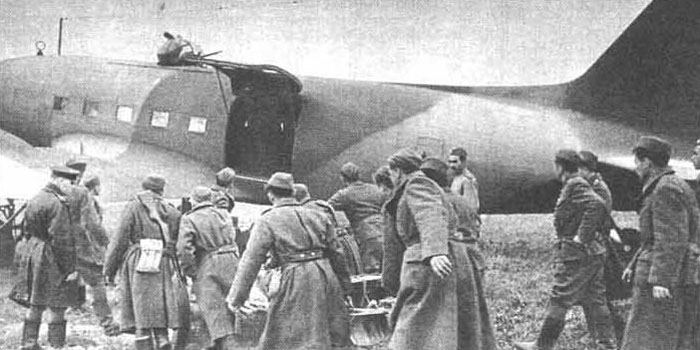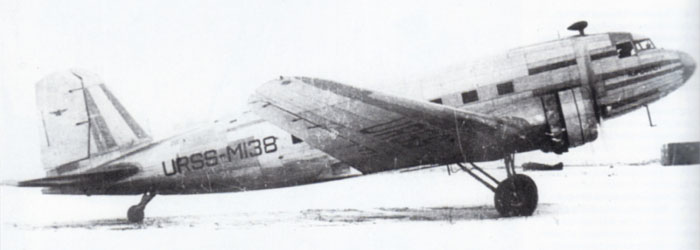
The first PS-84 (n.841) manifactured under licence in Factory n.84, It was assembled from DC-3 parts, except for the Soviet M-62IR engines (a development of the M-25, a licensed copy of the Wright Cyclone).
Compared to the DC-3 purchased in U.S, the photo shows the drop fairing of the radio-compass moved atop the fuselage.
It was registered on 8 May 1939 as URSS-M138 and assigned to the Moscow Administration of GFV (Civil Air Flot).
The plane is finished in natural metal, the different shining of different panels is evident.
Note that early PS-84 were built in passenger configuration, and were not provided with the large cargo door on the left side characteristic of wartime-built Li-2s.
From Red Stars n.4, of Geust and Petrov

A production PS-84 equipped with ski gear in winter 1940.
The plane has civil marks in cyrillic : CCCP-
The outside of the plane was painted silver, with unpainted propellers.
A very evident difference can be seen between the cowling front opening of PS-84, that was fully rounded, and DC-3, that had a flat top.
Note that the strut behind the landing gear legs was changed when ski gear was installed, while it remained similar to that of DC-3 when the standard retractable wheel gear was installed.
Before the war outbreak, 84 PS-84 were delivered to Aeroflot, 49 to the VVS and 5 to the Navy Air Force.
By the time Nazi Germany invaded the USSR on 22 June 1941, 237 PS-84s had been built at GAZ-84, all in civil passenger configuration.
From Red Stars n.4, of Geust and Petrov
 After
the war outbreak, the most of PS-84 and of the DC-3 bought before the war
were mobilised into six Air Groups for Special Duties (AGON)
After
the war outbreak, the most of PS-84 and of the DC-3 bought before the war
were mobilised into six Air Groups for Special Duties (AGON)
Image of wounded soldiers transported by the same plane.
Right: comparison between the engine cowling of DC-3/C-47 and of PS-84/Li-2.
(From Typi Broni)
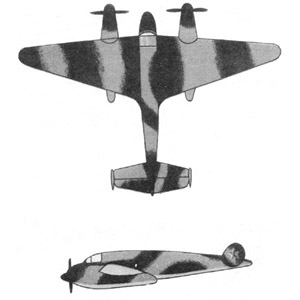 On
20 June 1941, the last day of peace, it was published an order of NKAP (the
Ministry for Aeronautical Industry) to paint all planes with a new standard
camouflage within one month.
On
20 June 1941, the last day of peace, it was published an order of NKAP (the
Ministry for Aeronautical Industry) to paint all planes with a new standard
camouflage within one month.
Already existing planes with uniform green uppersurfaces had to be added with matt black (A-26m oil paint for metal planes, and AMT-6 nitrocellulosic lacquer for mixed construction planes). Undersurfaces presumably preserved the original finish in A-18F or AII light blue; in the case of Li-2, they could have been left unpainted.
For newly built planes, the instructions said to utilize matt light blue for undersurfaces (not specified what type of paint, but all previous light blue paintings were gloss, so they have to be A-28m for all-metal planes and AMT-7 for mixed construction planes).
Apart for some Yaks, the first known photos of planes with the new green/black painting scheme are dated to July 13, 1941.
Many maintenance manuals of the first years of war describe these paints: dope AMT-4 green, AMT-6 black and AMT-7 blue enamel or oil A-24m, A-26m and A-28m of the same colours. Oil colors were less utilized, also because AMT colors can adhere well to primed metal surfaces. The control surfaces of Li-2 were fabric skinned, so AMT colors were necessarily utilized at least on them.
Despite their name (M= matt), AMT colors were semigloss when new, and turned to matt finish with ageing. Occasionally, they could have been overpainted with a layer of gloss varnish AB-4-d to improve aerodinamicity and gain some speed. Instead, A-xxm oil colors were matt even when new.
While AMT-4 and 6 were codified in July 1941, AMT-7 was codified in August 1941, and is not mentioned on earlier manuals; earlier AII light blue remained in use in parallel with the darker AMT-7 in the first years of war.
Oil enamels were intended to be sprayed on the exterior metal surfaces, even unprimed. Painting with a brush meant poor paint properties, and was allowed only as a second choice, ex. for repairs.
Prop blades were now fully painted black.
The order of June 1941 changed the national marks of planes too. Red stars, of plan type or with thin black outline, were now placed in six positions:
- one on each side of fuselage (not always applied; in facts, it has rarely seen on PS-84 and Li-2s),
- one on each side of rudder/stabilizer,
- one on the undersurface of each wing.
Note the deletion of stars over the wings, and the introduction of new ones on the tail.
Sometimes stars were outlined with white, silver or yellow borders, but this wasn't a standard.
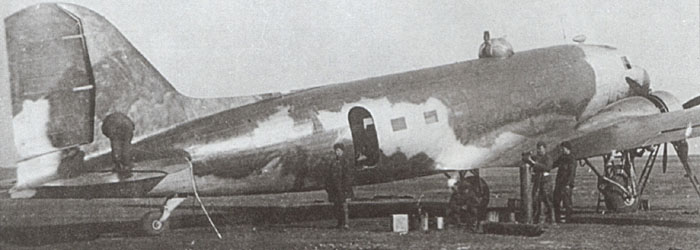
MV-3 turrets from crashed bombers were installed on the most of the existing PS-84 and DC-3; from the end of July 1941, the turret was adopted as a standard on all new PS-84.
This Li-2 was sprayed with green and black over the original aluminium or light grey livery. It looks that the painter is still doing his work while photographed, so, at the end, the silver probably had been completely covered by black. The pattern visible here is not identical to that of new-built Li-2s of 1941/43. Note that its side windows conform to the early airliner standard, lacking of the window on each side of the rear fuselage that was added on later planes to fit defensive armament.
From Li-2 of Maslov
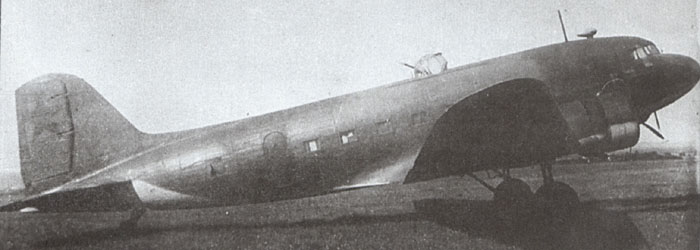
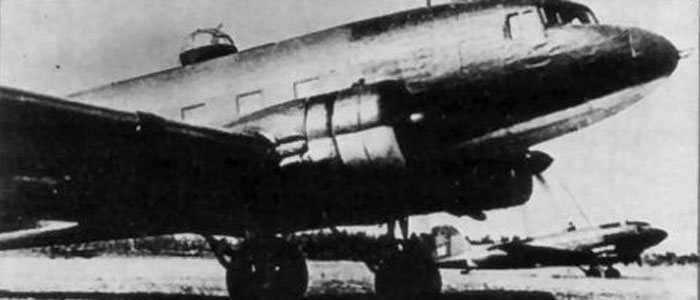
PS-84s of 1941-43 came out of the factory already provided for defensive armament:
- MV-3 turret with 7.62 mm ShKAS became standard on new produced planes at the end of July 1941; it was later upgraded to a UTK-1 turret with a UBT 12.7 mm machine gun.
- two 7.62 mm DA machine guns of similar caliber were provided, firing from newly opened hatches on the rear fuselage sides; the DA were later replaced by ShKAS of the same caliber;
- a fixed ShKAS mg(not visible here) was added on the nose, but it was scarcely useful and was often deleted.
The camouflage introduced in the summer of 1941 conforms to a main template with dark green with three large bands of black visible on each side. Large plain red stars were always painted on the rudder and below the wings, while they were not always present on the fuselage sides.
From Li-2 of Maslov
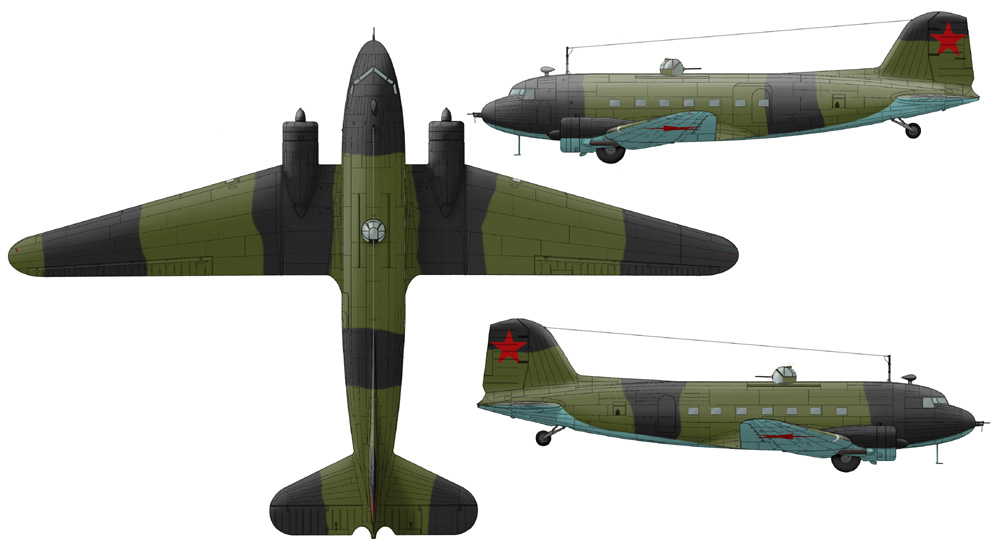
A drawing of the 3-banded camouflage, obtained from the photos available on this page. The left wing is not well shown on photos and was guessed.
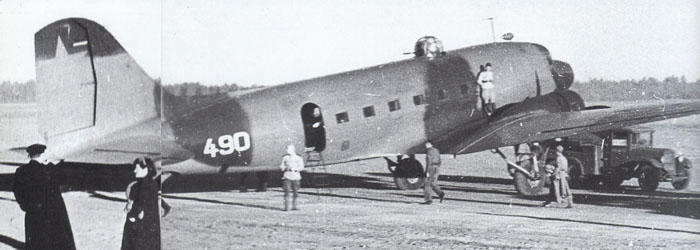
 A common
variant of the camouflage introduced in 1941 had 4 black bands visible on
each side.
A common
variant of the camouflage introduced in 1941 had 4 black bands visible on
each side.
White 490 photographed in Khvoinoye airport near Leningrad in 1943.
Note the inward-opening passengers door on the right side.
From Red Stars of Geust, Keskinen, Stenman
Right: detail of the engine cowling; the plane on the background shows a three-bands camo.

A drawing of the 4 banded camouflage obtained from photos. The left wing and the tip of the right wing, being not visible on available photos, are my guess.
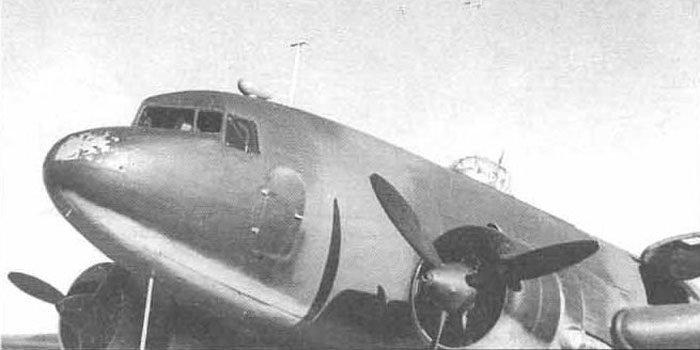
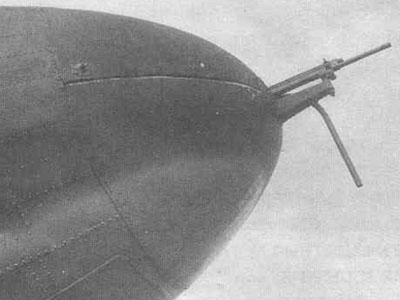 After
the arrest of Myashchishev, the leadership of the project passed to the chief
of Factory N.84, engineer V.P. Lisunov.
After
the arrest of Myashchishev, the leadership of the project passed to the chief
of Factory N.84, engineer V.P. Lisunov.
On 17 September 1942, the PS-84 designation was changed into Lisunov Li-2 in his honour.
A Li-2 with the black-green camouflage.
One can see the opened large cargo door on the left side.
Right: the fixed ShKAS often installed on the nose of Li-2s and its external support.
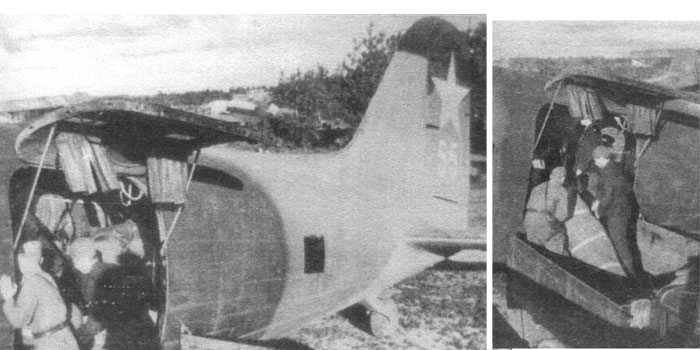
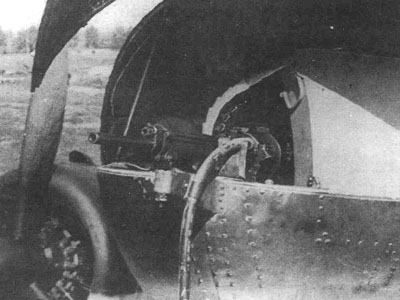 Li-2
white 55 being loaded from a truck. The large rectangular cargo door is visible;
it was introduced on the left side to give more versatility to the plane.
Li-2
white 55 being loaded from a truck. The large rectangular cargo door is visible;
it was introduced on the left side to give more versatility to the plane.
The marks and camouflage are characteristic of mid 1941-mid 1943 period.
Right: the open nose panel shows the ShKAS, its ammo box and a tube (for the expulsion of waste shells?).
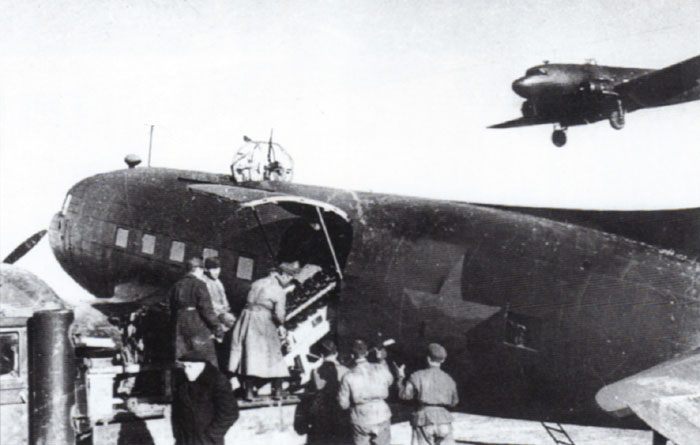
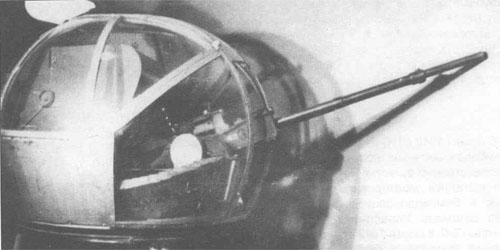 Li-2 unloaded
during the besiege of Leningrad.
Li-2 unloaded
during the besiege of Leningrad.
It shows strange discontinuities and repaintings on its camouflage
From Red Stars n.4 of Geust and Petrov.
Right: image of the UTK-1 turret with the UBT 12.7 mm machine gun. On photos, it can be distinguished from the ShKAS in similar ball-like turrets because the UBT has only one large barrel visible from the side, while the ShKAS is shorter and has the gas recover tube overposed to the barrel.
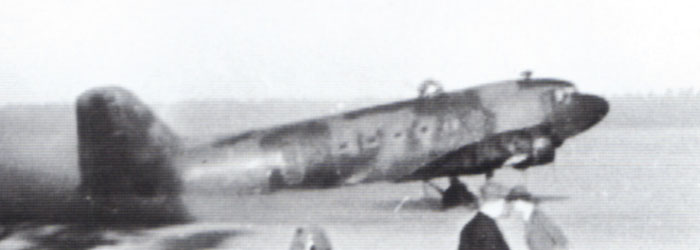
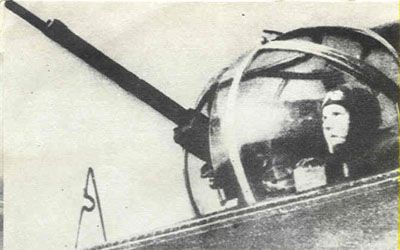 Another Li-2
with strange black and green repainting, apparently on the base of a standard
green/black camouflage. Note the large red star, scarcely visible on the
rear fuselage.
Another Li-2
with strange black and green repainting, apparently on the base of a standard
green/black camouflage. Note the large red star, scarcely visible on the
rear fuselage.
From Red Stars n.4, of Geust and Petrov
Right: another image of the turret with UBT 12.7 mm mg. The gas recover tube is on the left side of the barrel, as on Il-10.
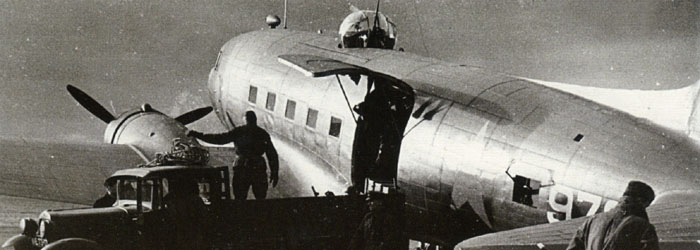
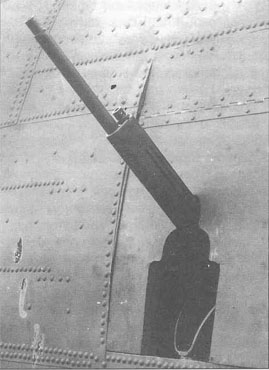 Although
shining in the sun, this plane has the usual four-banded disposition of black
bands on fuselage. Note the bort number of three digits and the star on the
fuselage. The barrel of the 7.62 mg is protruding from the rear window.
Although
shining in the sun, this plane has the usual four-banded disposition of black
bands on fuselage. Note the bort number of three digits and the star on the
fuselage. The barrel of the 7.62 mg is protruding from the rear window.
From Li-2 of Maslov
Right: a ShKAS protruding from the hatch on the side. The hatch was closed by a metal plate that can be opened upwards and inwards, and has a smaller recess to avoid interference with the mg support while opening. The hatch looks to have the same size of the windows on the fuselage sides.
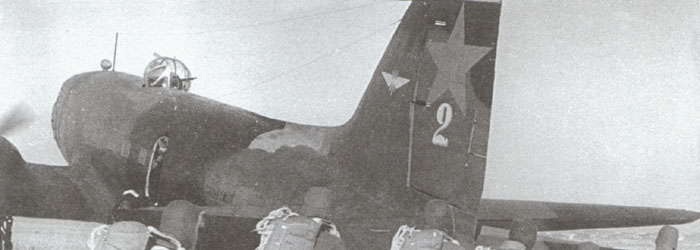
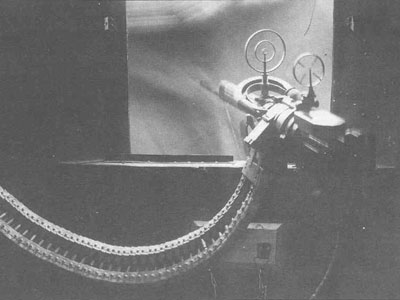 This
plane looks to conform to the same scheme. but modified with a brush application
of lighter color (probably AMT-1 light brown) on the rear fuselage, and possibly
with spray repaintings of the same color close to the turret and on the front
fuselage. Probably it's a pre-1943 plane whose scheme was modified after
1943, roughly conforming to the new standard of 3 colors camo.
This
plane looks to conform to the same scheme. but modified with a brush application
of lighter color (probably AMT-1 light brown) on the rear fuselage, and possibly
with spray repaintings of the same color close to the turret and on the front
fuselage. Probably it's a pre-1943 plane whose scheme was modified after
1943, roughly conforming to the new standard of 3 colors camo.
From Li-2 of Maslov
Right: the inside of the side mg position with the hatch open.
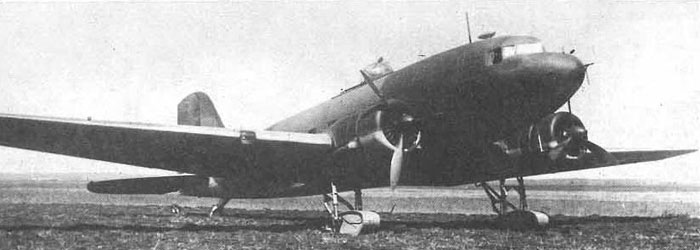
Two machines were fitted with tracked landing gear for testing on soft ground, but it was too heavy and unreliable to be useful and was not adopted.
The camo seem the three-bands variant of the typical one of mid 1941-mid 1943 period. Note the machine gun on the nose.
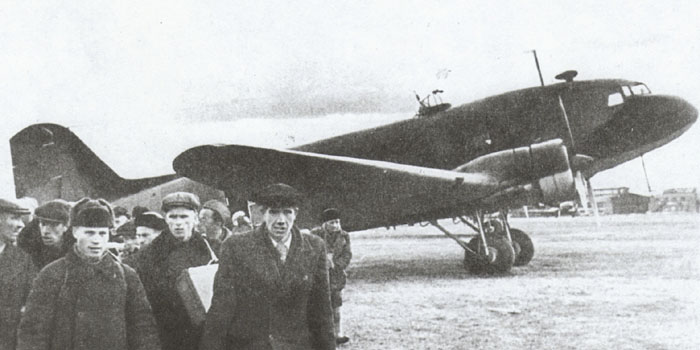

Two versions of the same photo appear surprisingly contrasting about the plane of this plane shot in 1942 during the siege of Leningrad.
At least one of the photos was heavily retouched, probably the upper one that has people in better evidence; the image below looks more likely about the plane.
The camouflage doesn't seem to follow the standard pattern seen above.
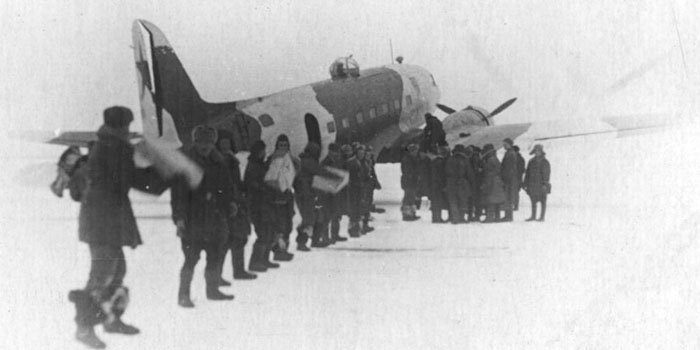
A Li-2 with a temporary winter scheme, probably in winter 1941 or 1942. The MK-7 white temporary paint covers completely wide bands that correspond well to the black bands of the standard black-green camouflage, so the look of the plane should be white and dark green.
No stars nor bort numbers are visible on the fuselage sides.
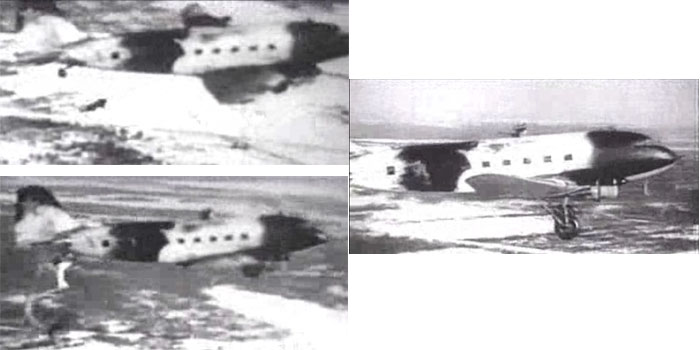
Three screenshots depicting a similar Li-2 launching paratroops. When compared to the photo of the plane above, the white camo looks inverted, and this suggests that covers all the dark green bands. So, the look of the plane should be white and black.
No stars nor bort numbers are visible on the fuselage sides.
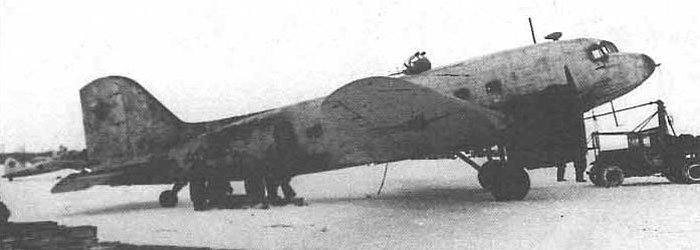
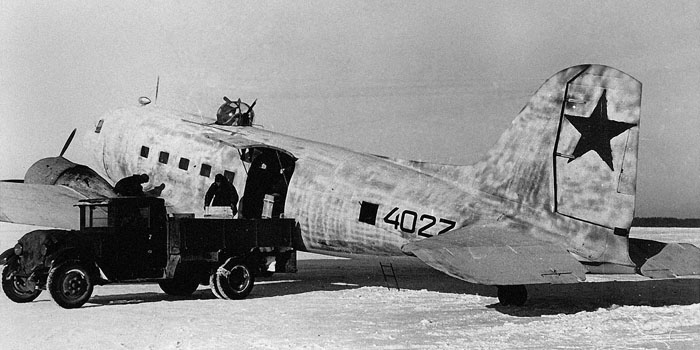
Li-2 black 4027 with winter livery made by overspraying the standard camouflage with thiny lines of MK-7 washable white. The strokes on the rear fuselage appear crossing.
From Li-2 of Maslov
A profile of 4027 is here:
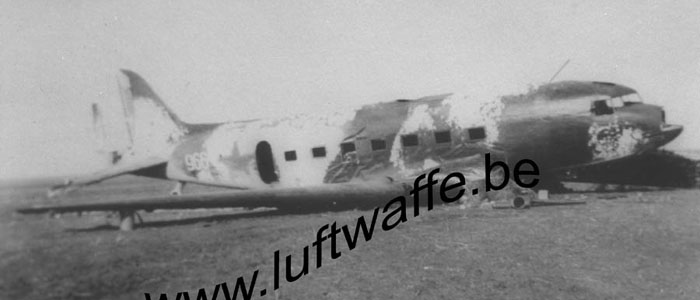
'White 966' was abandoned, probably in winter 1941/42. The base camo looks four-banded, and the white distemper looks added preminently, but not exclusively, on the green bands of the fuselage. Strangely, the outer panels of the wings appear without any white paint.
http://www.luftwaffe.be/photographs/aircraft/sovjet_planes.html
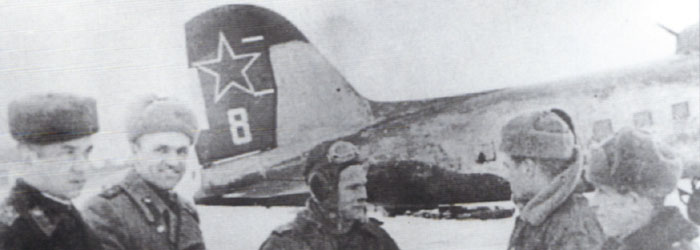
White 8 seems a black-green plane with a partial white winter camouflage overposed. The undersurfaces looks painted black for flies to refuel the besieged Leningrad in 1943.
From Red Stars 4 of Geust and Petrov
The directive n°2389/0133 of July 3, 1943, gave new instructions to paint the Soviet warplanes:
- the upper and side surfaces of all fighter aircraft were to have two colors: greyish blue and dark grey in the same scheme;
- upper and side surfaces of all types of aircraft but fighters had to be camouflaged in green, light brown and dark grey (black for Il-4 and Pe-8);
- the red stars remained in the same six positions of before, but were addictioned with a thick white outline and, more externally, with a further thin red outline.
- the directive applied to new planes and those in repair shops; it wasn't required that operative units repainted all their planes.
| Nitro lacquers for mixed construction planes | Oil enamels for all-metal planes | |
| light brown |  AMT-1 AMT-1 |
 A-21m A-21m |
| dark green |  AMT-4 AMT-4 |
 A-24m A-24m |
| black | not needed |  A-28m
(for Il-4 and Pe-8 only) A-28m
(for Il-4 and Pe-8 only) |
| light blue |  AMT-7 AMT-7 |
 A-28m A-28m |
| blue-grey |  AMT-11 AMT-11 |
not needed for non-fighter planes |
| dark grey |  AMT-12 AMT-12 |
 A-32m A-32m |
The directive assumed that the non-fighter planes had to be delivered with the new camouflage starting from August 1, 1943; in the days before, black had to be replaced with dark grey.
In case of absence of dark grey, this would have been replaced by a mix of light blue and black.
The directive contained 15 camouflage schemes for many types, of which 14 were for non-fighter planes, but none is included for Li-2s.
 A new deep
black, 'Noch', was introduced for the surfaces of night bombers, and was
widely utilized on the undersurfaces of the most of Li-2s. It was darker
than A-28m
A new deep
black, 'Noch', was introduced for the surfaces of night bombers, and was
widely utilized on the undersurfaces of the most of Li-2s. It was darker
than A-28m
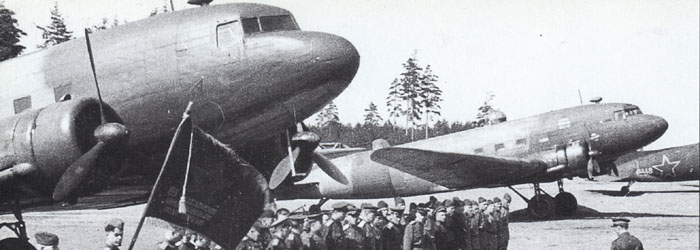
After the summer 1943, the new livery was adopted in at least two forms: one, with regular trasversal bands very similar to those of the standard black-green camouflage (as the closest two planes in this photo) and in a new, more rare and irregular pattern (as the plane on the background).
- the first two planes seem to have a faded two-shades old-fashioned livery; it is unclear if the old colors (black-green) are replaced by those of the new camouflage (brown-green-grey); note the light blue undersurfaces, rare in planes painted or built after the summer 1943, when light blue was replaced by black on the undersurfaces of the most of Li-2s;
- the plane on the background has a darker camouflage, still with light blue undersurfaces, and features an unusual red star on the fuselage sides.
From Red Stars of Geust, Keskinen, Stenman
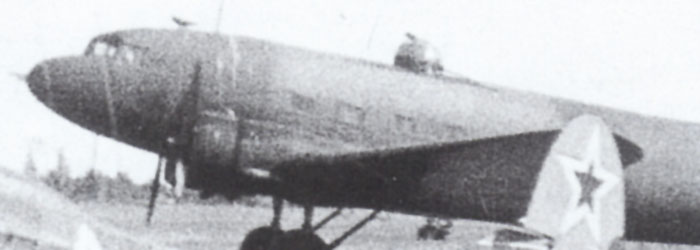
This plane is similar to the closer previous ones. Unfortunately, on bw photos dark green and dark grey are hardly distinguishable.
From Red Stars of Geust Keskinen, Stenman
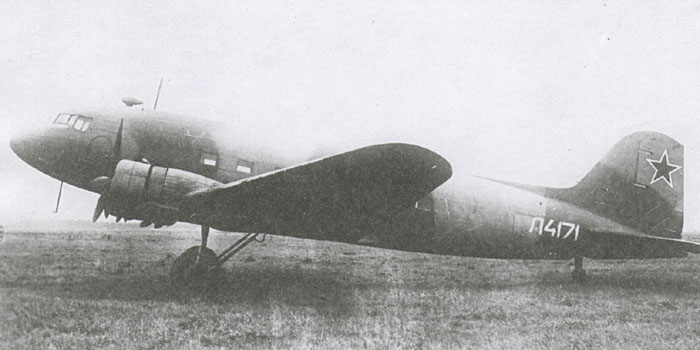
White L4171 has undoubtedly a three-shades livery, that seems a reverse four-bands livery; it seems that the black was replaced by light brown or another color, as on the cockpit; this color appears of intermediate shade and this is usually related to the dark green, that is slightly lighter than the dark grey; however the grey fades more quickly than green becoming lighter; I prefer to assume that this intermediate color was grey, also because green bands are expected to be more extended than grey ones in the 1943-45 camouflages.
From Li-2 of Maslov
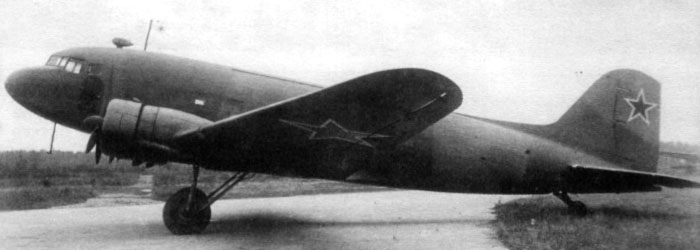

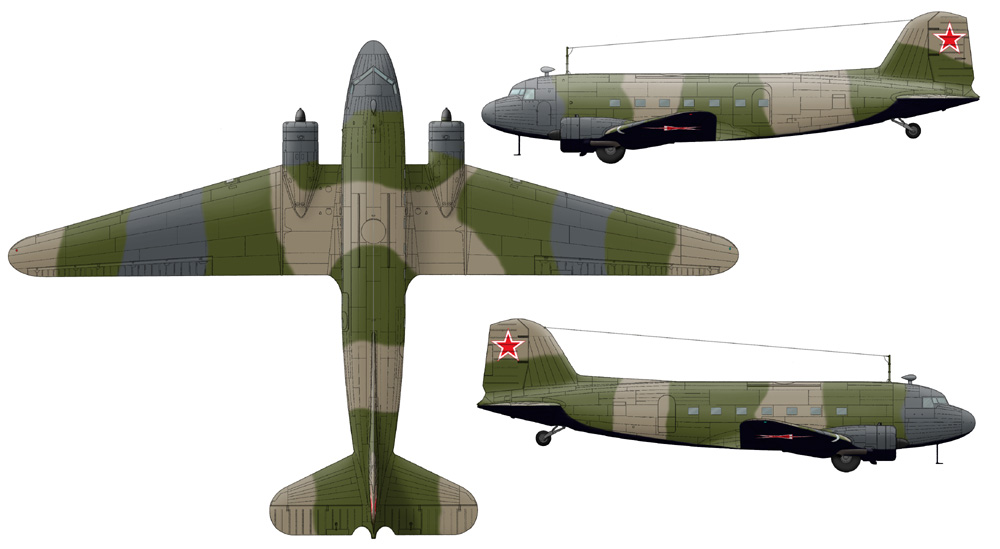
Here is an attempt to trace the a typical template common to the three planes above and many other ones, utilizing the evident resemblance to the four bands green-black scheme. The black was here replaced sometimes with light brown, sometimes with dark grey according to the photos, when possible.
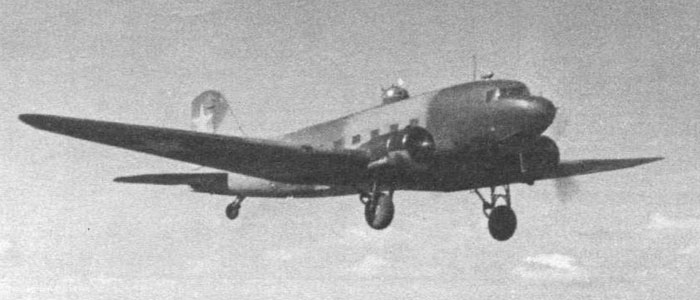
A 3-shades camouflaged plane on takeoff in 1943. The general disposition of bands is very similar to that of the black-green camouflage of 1941-43, but we can suppose that the lighter color in the photo is light brown, the other ones being dark green and dark grey.
Note the machine gun on its nose.

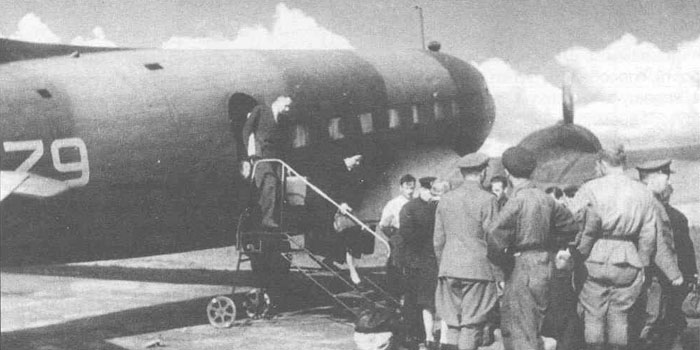
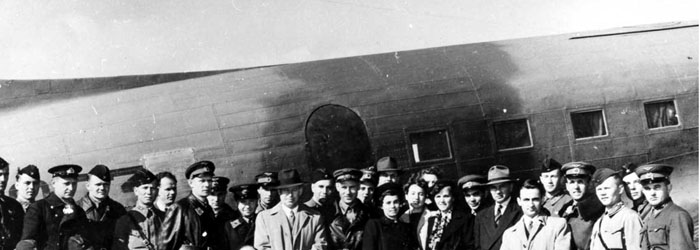
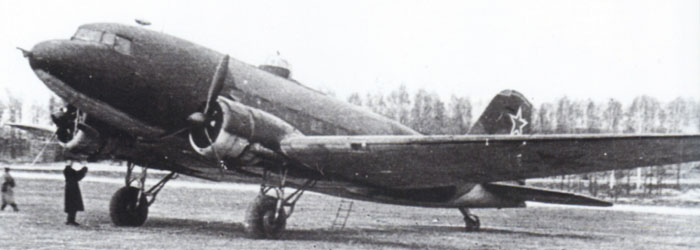
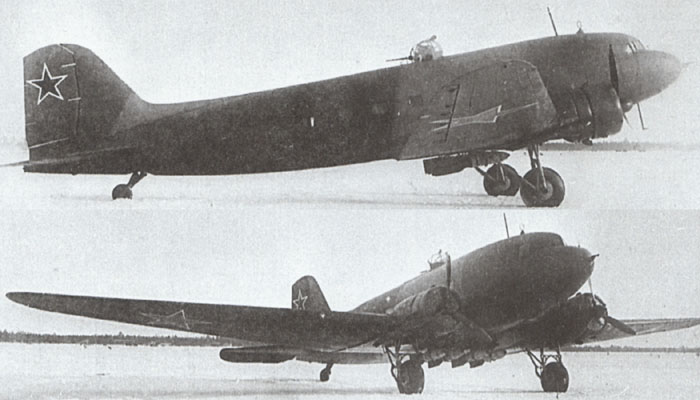
The night bombing version Li-2NB, where "NB" stood for "nochnoy bombardirovshchik (night bomber)", was developed in Spring 1942 for the Long Range Air Force (ADD). They usually carried an external load up to 1000 kg, usually four FAB-250 bombs.
A version with internally loaded bombs was tested in the late 1944, but didn't enter production.
Two images of Li-2NB n°18411906 adapted as a night bomber at NIIVVS in 1944. It looks to have a 3-shade camo (dark green, dark grey, light brown) and black undersurfaces. The image from the front let see the shutters plates to avoid excessive cooling of the engines during the winter.
The ring aerial on the top hasn't its drop-shaped cover; the exposed antenna is often seen on night bombers.
(From Maslov: Li-2)
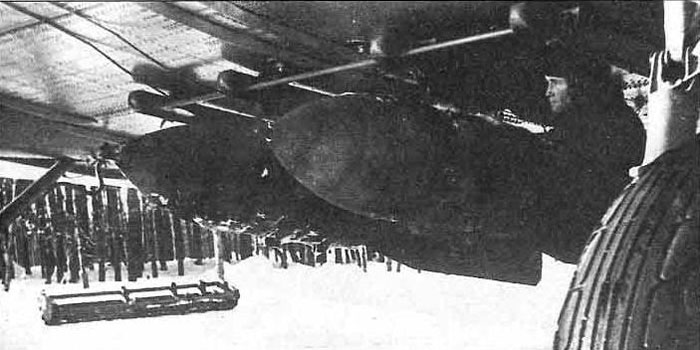
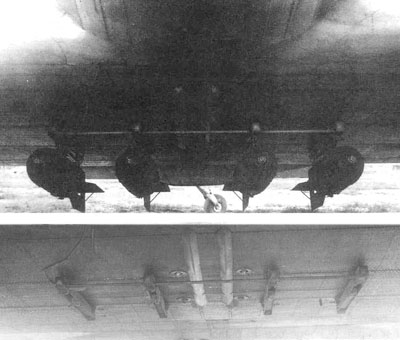
Left: a detail of the ventral bomb racks.
Right: a detail of the bombs rack, with and without the bombs load.
(from Aviakollectia 3/2005)
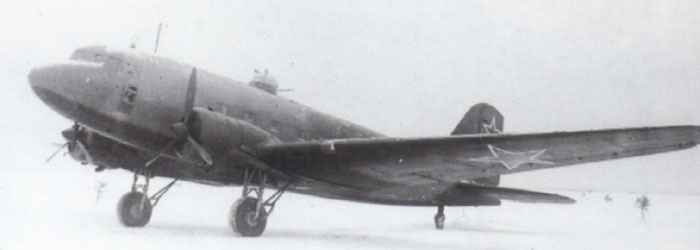
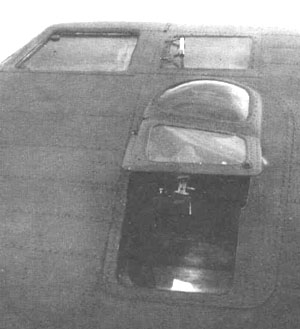 Li-2NB
of 12 AD, 7 AK of ADD in winter 1943-44. It looks to have 3 shades camouflage
and black undersurfaces. It's visible a window protruding on the left side
of the cockpit.
Li-2NB
of 12 AD, 7 AK of ADD in winter 1943-44. It looks to have 3 shades camouflage
and black undersurfaces. It's visible a window protruding on the left side
of the cockpit.
from Red Stars n.4 of Geust and Petrov
Right: a detail of the left side door. The upper window is bulged and closed; the mid panel is opened upwards to leave free sight to the NKPB-7 bomb sight inside; the lower panel is flat and fixed in closed position.
A new small window was opened behind that of the pilot on each side.
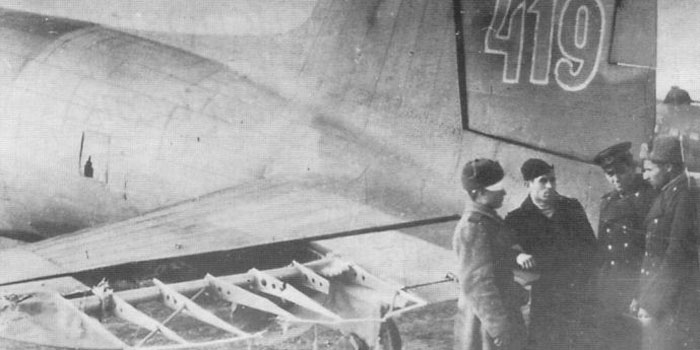
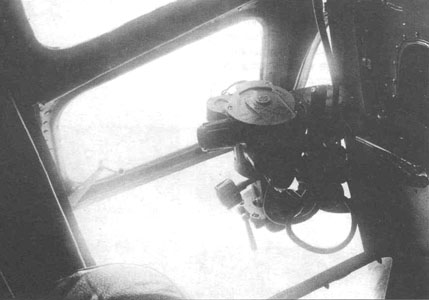 Li-2
(probably NB) n.419 features a 3 shades camouflage. The damage on the rudder
suggest that it was utilized as a night bomber.
Li-2
(probably NB) n.419 features a 3 shades camouflage. The damage on the rudder
suggest that it was utilized as a night bomber.
Note the slots for defensive 7,62 ShKAS machine guns on the rear window. The defensive armament included two of them in the rear fuselage, plus a fixed one on the nose and one 12.7 mm UBT on the turret.
About 600 Li-2NB were utilized by the ADD equipping up to 19 regiments; 384 of them were lost during the war.
Right: detail of the opened door from inside.
A profile of a similar plane is here:

Li-2 NB White 33 ready to takeoff for a night bombing mission on Ukrainan front on 30 December 1944 with four FAB-250 bombs.
On December 6, 1944, ADD (Long Range Air Force) was reorganized as 18th Air Army.
Although altered by the strong contrast of lights, the camouflage shows similarity in pattern to the old 3-banded black-green one, but probably it's a light brown-dark green-dark grey livery with strong predominance of light brown, as the plane of the photo above.
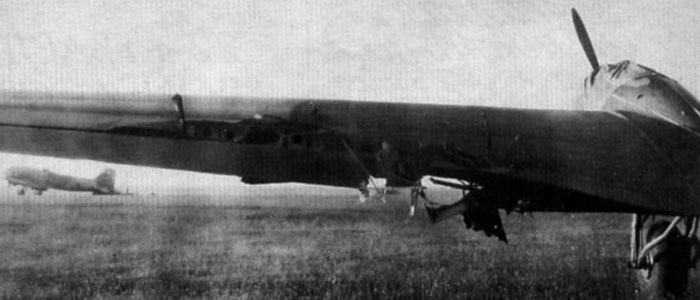
 A damaged
Li-2 wing; although unclear, the image can give an idea of the camouflage
on it.
A damaged
Li-2 wing; although unclear, the image can give an idea of the camouflage
on it.
Right: the tail of a Li-2 white 808 in late 1943. The camo pattern is of a 3-shades plane.
A profile of 808 is here:
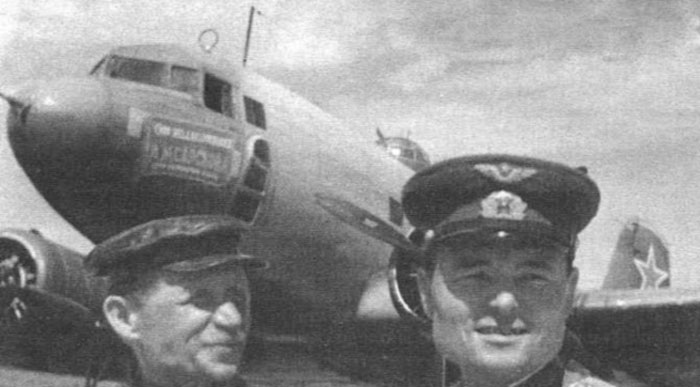
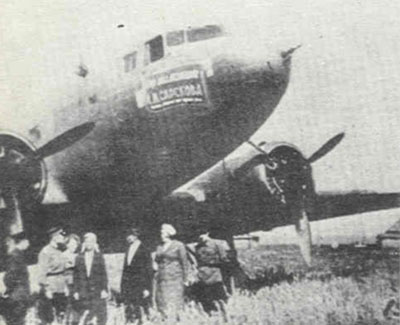 A
member of the Krasniy Looch kholkhoz, and F.N. Orlov in front of a donated
Li-2 with a large banner painted on its nose on July 10 1944. The camouflage
is clearly with 3 shades. The tail has a thin red cap.
A
member of the Krasniy Looch kholkhoz, and F.N. Orlov in front of a donated
Li-2 with a large banner painted on its nose on July 10 1944. The camouflage
is clearly with 3 shades. The tail has a thin red cap.
Bomb racks seem visible under the fuselage.
The plane has the additional bulged window for the bomb sight on the left side of the cockpit. The drop-shaped cover over the top is absent, leaving to see the ring-shaped aerial. One can also see the fixed ShKAS machine gun on the nose, and the additional window behind the pilot's one on each side..
from Red Stars n.4 of Geust and Petrov
Right: this image from Typi Broni shows that the banner was painted on both the sides of the nose.

Li 2 n. 1848703 was lost on a non-fatal crash during a post-repair test flight on March 13, 1944.
It has a 3 shades camo livery and, on its nose, an interesting mark of a white bear with a bomb (enlarged detail). Although the artworks refers clearly to a use as a bomber, the plane hasn't the typical side window of Li-2NB, nor black-finished undersurfaces.
An artist's interpretation is given here
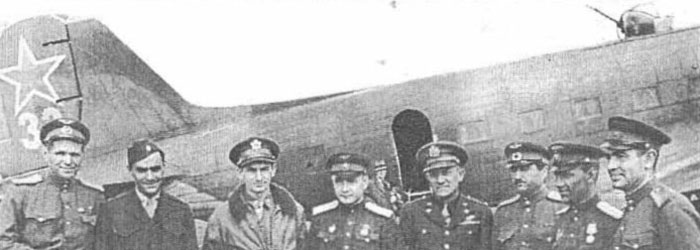

 above,
left:
above,
left:
Soviet and US officers posing in front of Li-2 white 32.
Below, left:
White 20 was camouflaged with natural materials, but thecamo livery is clearly with 3 shades.
Note the whita trim tab and the late style red stars on the rudder; no any star is visible on the fuselage side.
Right:
a drawing with camouflaged Li-2s traced by R.Caruana. Although the interpretation of colors is unreliable, it would be interesting to know the photographic references.
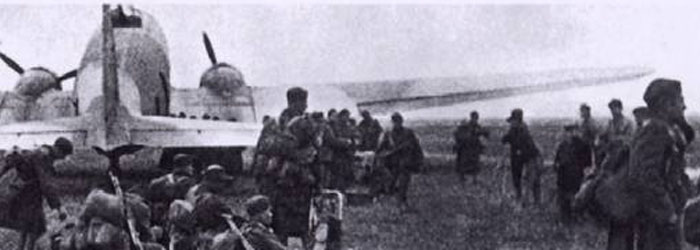
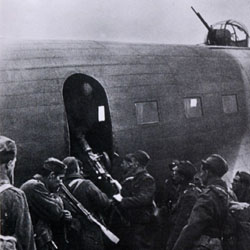 Interesting
view of a 3-shades camouflaged Li-2.
Interesting
view of a 3-shades camouflaged Li-2.
Right: another image, probably of the same plane.
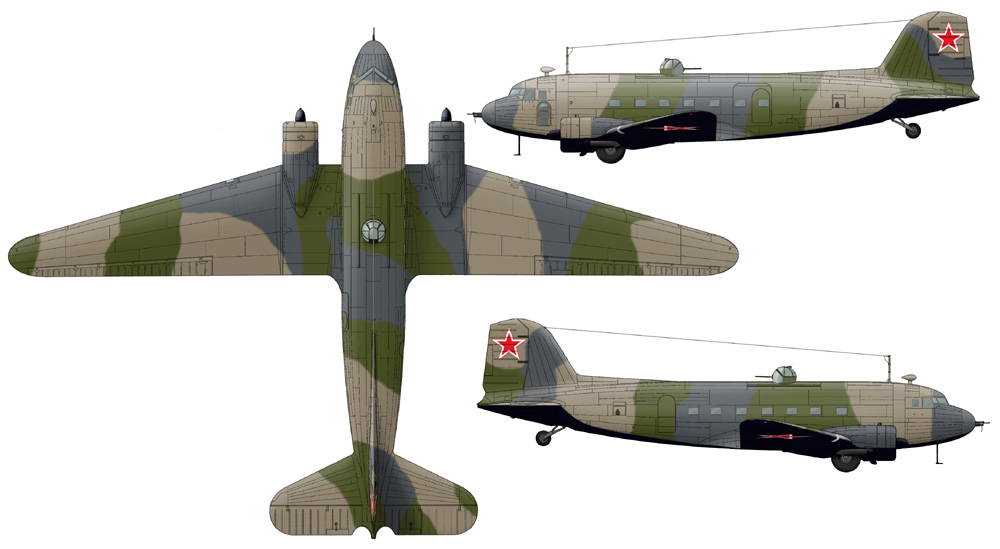
A sketch of a likely template for a camouflage, based mainly on three photos above and broadly compatible with many other ones. Although preserving some vague resemplance to the old green-black scheme, this camouflage looks more disordered and less repetitive.
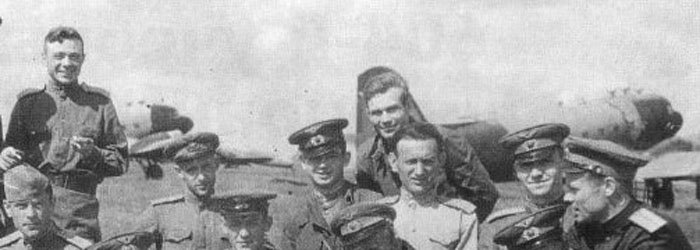
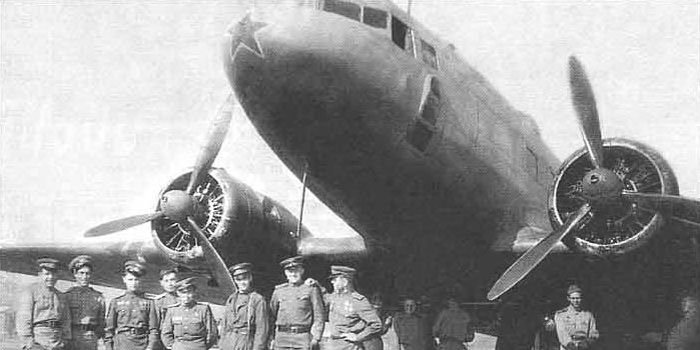

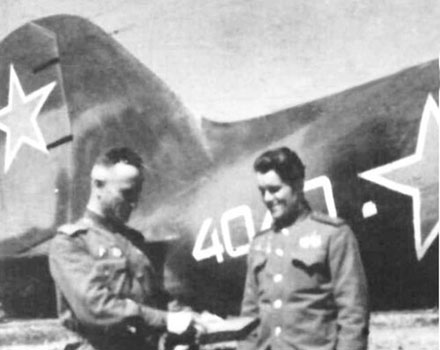
Left: Li-2 white 049 (or 4049?) with 3-shades camo.
from Red Stars
Right:
A close image of white 4040, with a complex camo and red stars both on the fuselage and on tail.


Unarmed Li-2 n.406 of the 23 OAP GVF (Detachet Aviation Regiment of the Civil Aviation Fleet) in 1945.
The inscription on the nose means 'Berlinskiy', an honorary name given to the regiment. The planes are unarmed, and still have a 3-shades camouflage with black undersurfaces.
In late 1944 the Soviet Air Force had altready reached a position of superiority over the German Luftwaffe and its alleys. While Germans reverted to green/brown camouflages to hide better their planes on the ground, the Soviets decided to extend to all planes the blue grey/dark grey camouflage that has been successful for fighters since August 1943.
On October 1, 1944, the Resolution n.6339 was approved, but burocratic delays retarded its publication till January 1945.
| Nitro lacquers for mixed construction planes | Oil enamels for all-metal planes | |
| light blue |  AMT-7 AMT-7 |
 A-28m A-28m |
| blue-grey |  AMT-11 AMT-11 |
 A-33m A-33m |
| dark grey |  AMT-12 AMT-12 |
 A-32m A-32m |
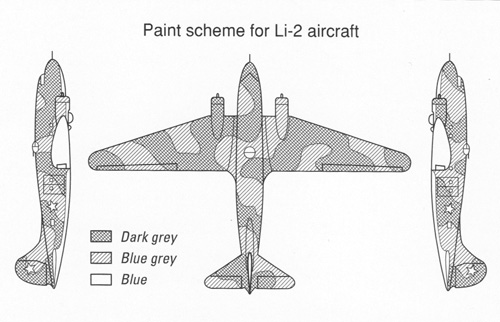 The
resolution included templates for many types of planes, including the Li-2
(see sketch aside).
The
resolution included templates for many types of planes, including the Li-2
(see sketch aside).
Comparing those drawings to the photos, there are doubts if the directive was applied, and how; very few types respect the new templates, but many planes could have been updated, as suggested by Orlov and Hornat, by repainting blue-green over green areas and dark grey over light brown areas. This would have led to a predominance of dark grey over blue-grey, but seems to be not a common case on photos.
On some Il-2s, it is proven that the light brown of the 3 shades scheme was replaced by blue-grey, obtaining a dark grey- green- blue grey camo.
From photos available, it seems that the blue grey-dark grey camo could really have been applied on Li-2s in 1945, but not respecting the template aside.
The undersurfaces were usually painted black, not only on night bombers, but on transport Li-2s too.
( sketch from 'Colors of the falcons' by Hornat and Migliardi)
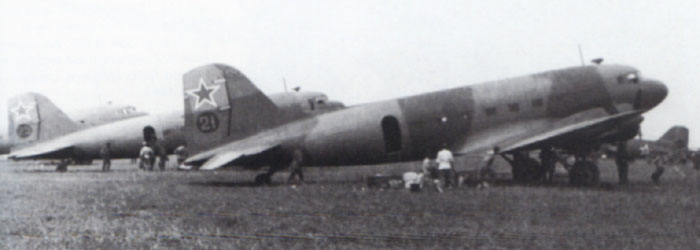

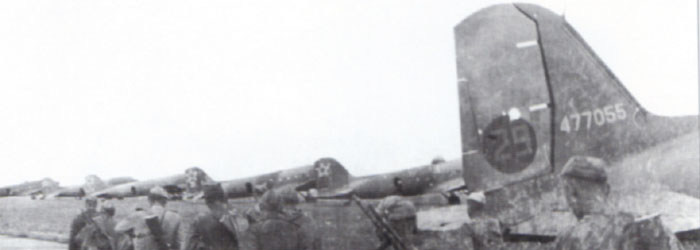
Top:
A line including some turretless Li-2 taken in Mukden, Manchuria, in August 1945.
Note the red (?) numbers (21 and 25) painted on black or dark blue disks.
The planes wear an unusual splinter camouflage, probably made with blue-grey and dark grey; its pattern doesn't fit at all with that suggested for Li-2 by the resolution 6339, but seems to have resemblance to an 'inverted' 4 bands pattern, where the black is replaced by the light color (blue-grey?) and the green by the darker color (dark grey?). Probably the resemblance is extended to the wings and tail surfaces too.
The second plane seem to have the same camouflage, but without the dark band on the tail.
Mid: plane white 6 seems to have an uniform color on its uppersurfaces (unclear if green or grey), and black undersurfaces.
The circular background of the white 6 is represented as dark blue on the profiles of Aviakollectia.
image from Aviakollectia 3/2005
A profile is here:
http://crimso.msk.ru/Images6/MA/MA99-4/27-3.jpg
Below: a C-47 of the same unit, apparently with OD livery. On the background, there are other splinter-camouflaged Li-2s.
Image from Red Stars 4, of Geust and Petrov.
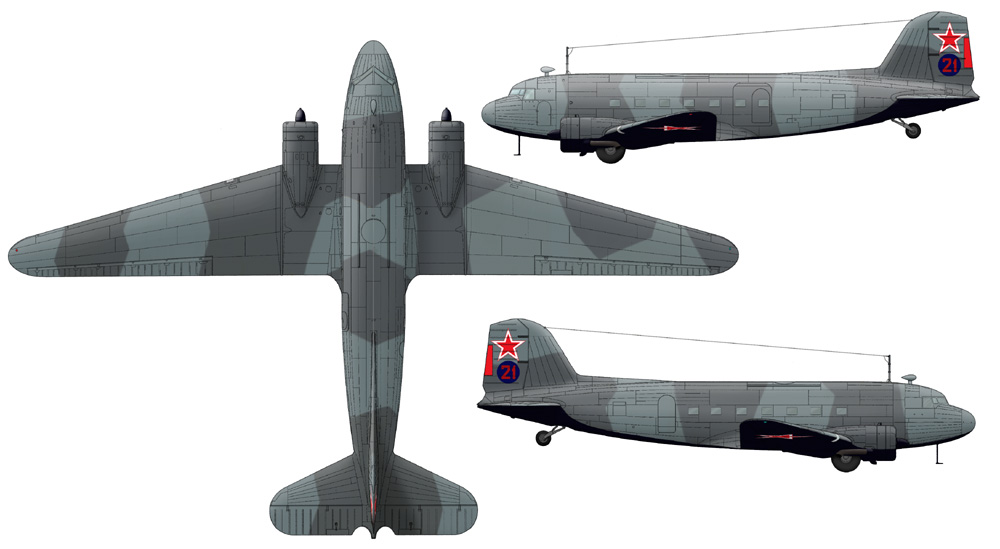
An hypothetical pattern of the fighter-like camouflage of red 21 on the base of the image above and of the supposed previous painting. The colors should be: AMT-11 blue-grey and AMT-12 dark grey, at least on the fabric-covered surfaces, while they could be A-32m and A-33m on the metallic surfaces. The undersurfaces are supposed painted with 'Nach' deep black.
